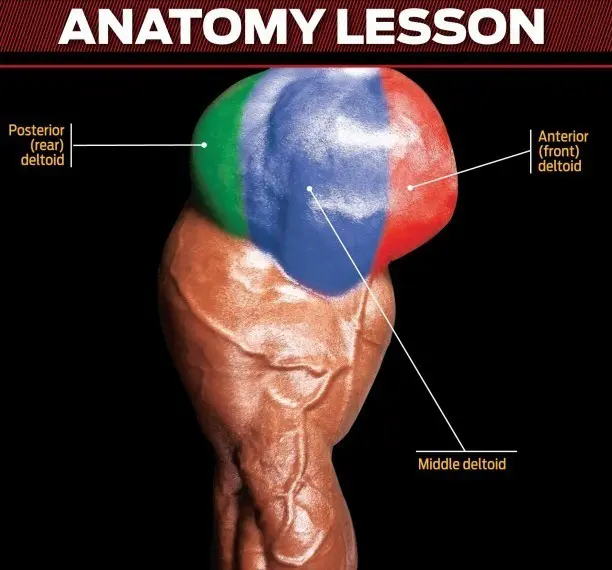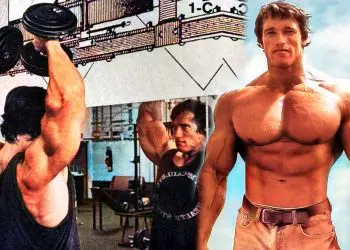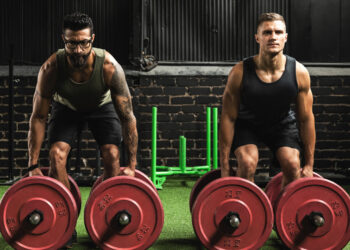Well-developed shoulders can add a lot to your physique. They give your upper body its width and look impressive even when you’re fully dressed.
If you train in a gym, training your shoulders usually means some form of overhead press, followed by a couple of isolation exercises, such as lateral and rear delt raises. But what if you train at home and don’t have access to any workout equipment?
As a veteran personal trainer with 35 years of experience, I’ve helped numerous people build jacked shoulders with nothing more than their bodyweight.
In this article, I reveal the 12 best bodyweight shoulder exercises and provide you with a sample workout to follow.
Recent Updates: On July 11, 2024, Fitness Volt’s Senior Editor Vidur Saini (American Council on Exercise-CPT) updated the article and added actionable expert tips throughout the piece to improve the reader experience. Level Up Your Fitness: Join our 💪 strong community in Fitness Volt Newsletter. Get daily inspiration, expert-backed workouts, nutrition tips, the latest in strength sports, and the support you need to reach your goals. Subscribe for free!
12 Best Bodyweight Shoulder Exercises
Add the following movements to your exercise arsenal:
- Pike Push-Up
- Handstand Hold
- Handstand Push-Up
- Shoulder Tap
- Plank To Alternating Pike
- Wall Walk
- T-Plank
- Doorway Lateral Raise
- Wall Angel
- High Reverse Plank
- Wide Grip Inverted Row
- Shoulder Circles
1. Pike push-up
| Sets & Reps | Equipment Needed | Target Muscles |
| 3 x 8-12 | None | Anterior Deltoid, Triceps Brachii, Serratus Anterior |
Push-ups are one of the most popular exercises on the planet. Regular push-ups work your chest and triceps, and your anterior deltoids are also involved. Make push-ups more deltoid-centric by doing this pike variation.
“Pike push-ups are a fantastic exercise for building shoulder strength and stability while also hitting the triceps and core,” says Saini. Keep your core engaged throughout the movement to avoid arching your back.
How to do it:
- Place your hands on the floor about shoulder-width apart, fingers pointing forward. Walk your feet back, so your body is straight. Brace your abs.
- Lift your butt into the air, so your body resembles an inverted V. Keep your legs straight.
- Bend your arms and lower your forehead to the floor.
- Push back up and repeat.
- Make this exercise harder by placing your hands on blocks or push-up bars or placing your feet on an exercise bench.
Pro Tip: Initiate the movement by protracting your scapulae (rounding your shoulders forward) at the bottom of the push-up, then retract them (pulling your shoulder blades together) as you press back up to engage the serratus anterior and improve shoulder stability.
| Difficulty | Progression | Regression |
| Intermediate | Handstand Push-Up | Elevated Pike Push-Up (Hands on a bench) |
2. Handstand hold
| Sets & Reps | Equipment Needed | Target Muscles |
| 3 x 30-60 seconds (or as long as possible with good form) | Wall, Open Space | Shoulders (all 3 heads), Trapezius, Core |

Handstand holds are the bodyweight equivalent of holding a heavy weight over your head. Providing you maintain muscle tension, this exercise will help strengthen all three deltoid heads while increasing shoulder joint stability. This is also an excellent upper trap exercise.
Saini adds that Handstands are not just about shoulder and arm strength; they also demand tremendous core activation and proprioception.
How to do it:
- Squat down in front of a smooth wall. Place your hands on the floor about 12 to 18 inches away and shoulder-width apart, fingers pointing forward.
- Kick yourself up and into a handstand, with your heels resting against the wall for balance.
- Imagine you are “pushing the floor away” to maximize deltoid activation.
- Hold for as long as you comfortably can, returning to the floor before your arms give out.
Pro Tip: Focus on actively pushing the floor away with your hands while maintaining a hollow body position. This will help engage your lats and core, improving overall stability and control in the handstand.
| Difficulty | Progression | Regression |
| Advanced | Handstand Push-Up | Wall Walks |
3. Handstand push-up
| Sets & Reps | Equipment Needed | Target Muscles |
| 3 x 5-8 | Wall, Open Space | Anterior Deltoid, Triceps Brachii, Serratus Anterior, Upper Pectoralis Major |
If you’ve mastered pike push-ups and handstand holds, you’re probably ready for a more challenging exercise — handstand push-ups. Be warned; this is a demanding exercise as you must lift your body weight using just your arms. If you can’t do dips with relative ease, do not attempt this exercise. Place a cushion below your head for safety.
Saini suggests progressing gradually by building up your handstand hold time and using wall assistance before attempting free-standing reps.
How to do it:
- Squat down in front of a smooth wall. Place your hands on the floor about 12 to 18 inches away and shoulder-width apart, fingers pointing forward.
- Kick yourself up and into a handstand, with your heels resting against the wall for balance.
- Bend your arms and lower your head to within an inch of the floor.
- Push yourself back up and repeat.
- Place your hands on blocks or push-up handles to make this exercise harder, increasing your range of motion.
Pro Tip: Control the descent by eccentrically contracting your serratus anterior to prevent your shoulders from collapsing forward.
| Difficulty | Progression | Regression |
| Advanced | Deficit Handstand Push-Up (Hands on parallettes) | Pike Push-Up |
4. Shoulder tap
| Sets & Reps | Equipment Needed | Target Muscles |
| 3 x 10-15 per side | None | Core, Shoulders (all 3 heads) |
This exercise is usually thought of as a core exercise, but it’s also great for your shoulders. During this exercise, you’ll need to stabilize your body weight using just one arm, making it a great way to strengthen your rotator cuff. And yes, your core will get a good workout too!
Per Saini, shoulder taps are a simple yet highly effective exercise for challenging your core stability and shoulder strength under dynamic conditions.
How to do it:
- Adopt the regular push-up position with your hands shoulder-width apart and your legs and arms straight. Brace your abs.
- Bend one arm and touch your opposite shoulder with your hand.
- Put your hand back down and repeat on the other side.
- Continue swapping sides for the duration of your set.
- Make this exercise easier by bending your legs and resting on your knees.
Pro Tip: Engage your glutes and quads isometrically to create a stable base, prevent your hips from rocking, and help you maintain proper form.
| Difficulty | Progression | Regression |
| Intermediate | Plank with single-arm reach | Plank |
5. Plank to alternating pike
| Sets & Reps | Equipment Needed | Target Muscles |
| 3 x 8-12 per side | None | Core, Shoulders (all 3 heads), Triceps Brachii |
This exercise is a more demanding version of shoulder taps. It also works your core, but you’ll have to work extra hard to transition from the plank position to the pike, which increases deltoid activation.
“This exercise is a great way to integrate shoulder mobility with core strength and stability,” says Saini.
How to do it:
- Adopt the regular push-up position with your hands shoulder-width apart and your legs and arms straight. Brace your abs.
- Lift your hips and push back with your arms.
- As your hips start to rise, lift one arm and reach back and touch your opposite knee, shin, or foot.
- Return to the push-up position and repeat on the opposite side.
Pro Tip: Pull your toes towards your hands as you pike rather than simply lifting your hip to emphasize core engagement and improve the overall efficiency of the movement.
| Difficulty | Progression | Regression |
| Intermediate | Pike Push-Up | Plank Knee-to-Elbow |
6. Wall walk
| Sets & Reps | Equipment Needed | Target Muscles |
| 3 x 5-8 | Wall, Open Space | Shoulders (all 3 heads), Triceps Brachii, Core |
If you aren’t quite ready for handstand push-ups but still want a demanding shoulder workout, this could be the exercise for you. Working your deltoids, triceps, and core, this move will develop the stability and strength you need to do full-handstand push-ups. It’s also a killer core workout.
Saini recommends starting with smaller distances and gradually working your way up as you gain confidence and proficiency.
How to do it:
- Adopt the push-up position with your arms straight and your feet against a flat wall. Brace your abs.
- Walk your hands back and your feet up the wall until you are in a handstand position.
- Walk your hands forward and feet down until you are back in the push-up position with your feet against the wall.
- Stop here or, if you are feeling strong, repeat.
Pro Tip: Keep your core as tight as possible to prevent your hips from sagging and your lower back from arching excessively.
| Difficulty | Progression | Regression |
| Advanced | Handstand Hold | Pike Push-Up |
7. T-plank
| Sets & Reps | Equipment Needed | Target Muscles |
| 3 x 15-30 seconds per side | None | Obliques, Core, Shoulders |
This plank variation works your core, especially your obliques, as well as your deltoids. You’ll need to work hard to keep your shoulder joint solid and stable.
Saini reveals that the T-plank is a challenging side plank variation that targets the obliques and shoulders. Keep your hips lifted and your body in a straight line for optimal core engagement.
Level Up Your Fitness: Join our 💪 strong community in Fitness Volt Newsletter. Get daily inspiration, expert-backed workouts, nutrition tips, the latest in strength sports, and the support you need to reach your goals. Subscribe for free!
How to do it:
- Squat down and place one hand flat on the floor.
- Keeping your arm straight, walk your feet out and away, so your weight is supported on your hand and feet only. Stack your feet, so one is on top of the other.
- With your shoulders and hips square, reach your other arm up toward the ceiling, creating the T-shape this exercise is named after.
- Hold this position for as long as you can, and then switch sides.
Pro Tip: Focus on stacking your shoulders vertically over your wrists and actively pressing the floor away.
| Difficulty | Progression | Regression |
| Intermediate | Weighted Variation | Side Plank |
8. Doorway lateral raise
| Sets & Reps | Equipment Needed | Target Muscles |
| 3 x 10-15 | Door Frame | Medial Deltoid |
This is one of the few bodyweight exercises to isolate your medial deltoids. If you want broader shoulders, this is the exercise you need to do. Doorway lateral raises are an isometric exercise, meaning there is no movement. However, it’s still an effective way to build your shoulders.
Saini adds that the doorway lateral raises are a great exercise for isolating the medial deltoids for people who train at home. Use a slight pause at the top of each repetition to maximize muscle activation.
How to do it:
- Stand in a doorway. Place your forearms against the inner frame. Brace your abs and pull your shoulders down and back.
- Push your arms outward against the door frame. Push as hard and as long as you can. Do not hold your breath.
- Relax a moment and repeat.
Pro Tip: Lean slightly forward from the hips and keep a micro-bend in your elbows throughout the movement to bias the medial deltoids.
| Difficulty | Progression | Regression |
| Beginner | Standing Dumbbell Lateral Raise | No equipment lateral raise (arms only) |
9. Wall angel
| Sets & Reps | Equipment Needed | Target Muscles |
| 3 x 15-20 | Wall | Anterior Deltoids, Serratus Anterior, Rhomboids, Middle Trapezius |
Wall angels are a postural exercise that works your posterior deltoids, middle traps, and rhomboids. It also provides your chest with a useful stretch. Do this exercise to offset the effect of sitting hunched over your computer keyboard.
“Focus on maintaining contact between your hands, arms, and back against the wall throughout the movement,” cues Saini.
How to do it:
- Stand with your back against a smooth wall, feet a few inches out in front of you.
- Bend your elbows to 90-degrees and press them against the wall. Your elbows should be roughly level with your shoulders. Press the backs of your hands flat against the wall, too.
- Without moving away from the wall, slide your hands up the wall as far as you can. Keep pressing your arms and shoulders back.
- Return to the starting position and repeat.
- You can also do this exercise lying flat on the floor, which may feel a little easier.
Pro Tip: Imagine you are trying to pull your elbows and wrists together as you slide your arms up the wall.
| Difficulty | Progression | Regression |
| Beginner | Wall Angel with Overhead Reach | Partial Range of Motion |
10. High reverse plank
| Sets & Reps | Equipment Needed | Target Muscles |
| 3 x 30-60 seconds | Bodyweight | Core, Shoulders, Triceps Brachii |
The high reverse plank is a glute and lower back exercise that also provides your posterior deltoids with an effective workout. It’s also an excellent way to stretch and mobilize your shoulders but, if you’ve got very tight pecs, you may find this exercise very challenging.
High reverse planks are a great way to strengthen your posterior chain and shoulders.
How to do it:
- Sit on the floor with your legs straight and your torso upright. Place your hands on the floor next to or slightly behind your hips, fingers pointing backward.
- Keeping your arms straight, lift your hips, and look up and back toward the ceiling.
- Hold for a static contraction, e.g., 30 seconds, or lower your butt to the floor and do reps instead.
- You can also do this exercise while resting on your elbows, which is called a low reverse plank.
Pro Tip: Actively drive your heels into the floor and keep your chin tucked to create full-body tension and help prevent your hips from sagging.
| Difficulty | Progression | Regression |
| Intermediate | Single-Leg Reverse Plank | Reverse Plank (Knees Bent) |
11. Wide grip inverted row
| Sets & Reps | Equipment Needed | Target Muscles |
| 3 x 8-12 | Barbell, Suspension Trainer, or Sturdy Table | Latissimus Dorsi, Biceps Brachii, Rhomboids, Middle Trapezius, Shoulders |
Inverted rows are a bodyweight back exercise. But, done with a wide grip, they also work your posterior deltoids. All you need for this exercise is a bar set to about hip height, and you can also do it using a suspension trainer, such as a TRX.
Saini suggests focusing on pulling your chest towards the bar and squeezing your shoulder blades together.
How to do it:
- Sit on the floor below your bar. Hold it with an overhand wider than shoulder-width grip.
- Lift your hips off the floor, so your body is straight.
- Bend your arms and pull your chest up to the bar. Keep your wrists straight and focus on pulling your shoulders down and back. Lead with your elbows.
- Extend your arms and repeat.
- Make this exercise harder by placing your feet on an exercise bench or step. Make it easier by raising the bar to take some of the weight off your arms.
Pro Tip: Initiate the movement by retracting your scapulae (pulling your shoulder blades together) before pulling your chest towards the bar.
| Difficulty | Progression | Regression |
| Intermediate | Wide Grip Pull-Up | Inclined Inverted Row (Higher Feet Position) |
12. Shoulder circles
| Sets & Reps | Equipment Needed | Target Muscles |
| 3 x 10-15 forward, 10-15 backward | Bodyweight | Shoulders (all 3 heads), Rotator Cuff |
This is a popular exercise in traditional martial arts. It’s good for building endurance, and the lactic acid burn may help increase your mental toughness and tolerance for pain. On the downside, the better you get at this exercise, the longer you’ll be able to do it, and that can lead to very long workouts!
Per Saini, shoulder circles are a simple yet valuable exercise for warming up the shoulders and improving the range of motion.
How to do it:
- Stand with your feet together and your arms by your side. Raise your arms up and out, so they’re parallel to the floor.
- Without bending your elbows, make small circles with your arms. You can go forward, backward, or do a few of each.
- Continue until you are no longer able to keep your arms up.
- You can also do this exercise with your arms extended in front of you.
Pro Tip: Perform the circles in both directions (clockwise and counterclockwise) to ensure balanced mobility and stability in your shoulder joint.
| Difficulty | Progression | Regression |
| Beginner | Shoulder Circles with light weights | Smaller circles, slower pace |
Bodyweight Shoulder Workout
Not sure how to start doing bodyweight shoulder exercises? No problem; we’ve got you covered!
Do the following workout 1-2 times per week. If you do it twice, make sure you allow a few days for recovery and muscle growth, e.g., Monday and Thursday. Before you start, remember to warm up. A thorough warm-up will reduce your risk of injury and increase the effectiveness of your workout.
Jog or jump rope for 5-10 minutes, and then do a few mobility and dynamic flexibility exercises for your shoulders.
| Exercise | Sets | Reps | Recovery | |
| 1 | Pike push-up | 2-4 | 6-12 | 60-90 seconds |
| 2 | Handstand hold | 1-2 | ALAP* | 60-90 seconds |
| 3 | Plank to alternating pike | 2-4 | 6-12 per side | 60-90 seconds |
| 4 | Doorway lateral raise | 2-4 | 30-60 seconds | 60-90 seconds |
| 5 | Wall angel | 2-4 | 6-12 | 60-90 seconds |
| 6 | Shoulder circles | 1-2 | AMRAP** | 60-90 seconds |
* As Long As Possible, **As Many Reps As Possible
Shoulder Anatomy
The correct anatomical name for the muscles that make up your shoulders is deltoids. The deltoids cap your shoulder joint like football pads. There are three deltoids – anterior, medial, and posterior, and each one has a different function.

Anterior deltoids
Located on the front of your shoulder joint, the anterior deltoid is responsible for flexion and medial rotation of your upper arm. It’s involved in most pressing exercises, including bench presses and overhead presses.
Medial deltoid
Responsible for the abduction of your upper arm, the medial or middle deltoid is on the side of your shoulder. It gives your shoulders their width. Exercises that target this muscle include cable and dumbbell lateral raises.
Posterior deltoids
Located on the back of your shoulder, the posterior deltoid is responsible for external rotation and extension of your upper arm. Of the three deltoids, the rear delt is the most likely to be underdeveloped. Exercises that work the posterior deltoid include face pulls and reverse flyes.
Rotator cuff
The rotator cuff is made up of four muscles; supraspinatus, infraspinatus, teres minor, and subscapularis. These muscles help stabilize your shoulder joint and also work with the deltoids to flex, extend, abduct and rotate your shoulder joint. They might be small, but the rotator cuff muscles are critical for shoulder function and health. Weak rotator cuffs are a common cause of shoulder pain.
Wrapping Up
Your shoulders are the most mobile joint in the human body, capable of a wide range of motion and lots of different movements. Unfortunately, this mobility comes at a price – stability. This inherent lack of stability means your shoulders are also one of the most injury-prone body parts. Most lifters suffer shoulder pain at time point.
You can keep your shoulders strong and muscular with barbell and dumbbell exercises, but bodyweight exercises are often just as effective. Many of them are more joint-friendly too.
Don’t let a lack of training equipment stop you from developing shoulders you can be proud of. User these 12 proven exercises to sculpt the deltoids of your dreams.








